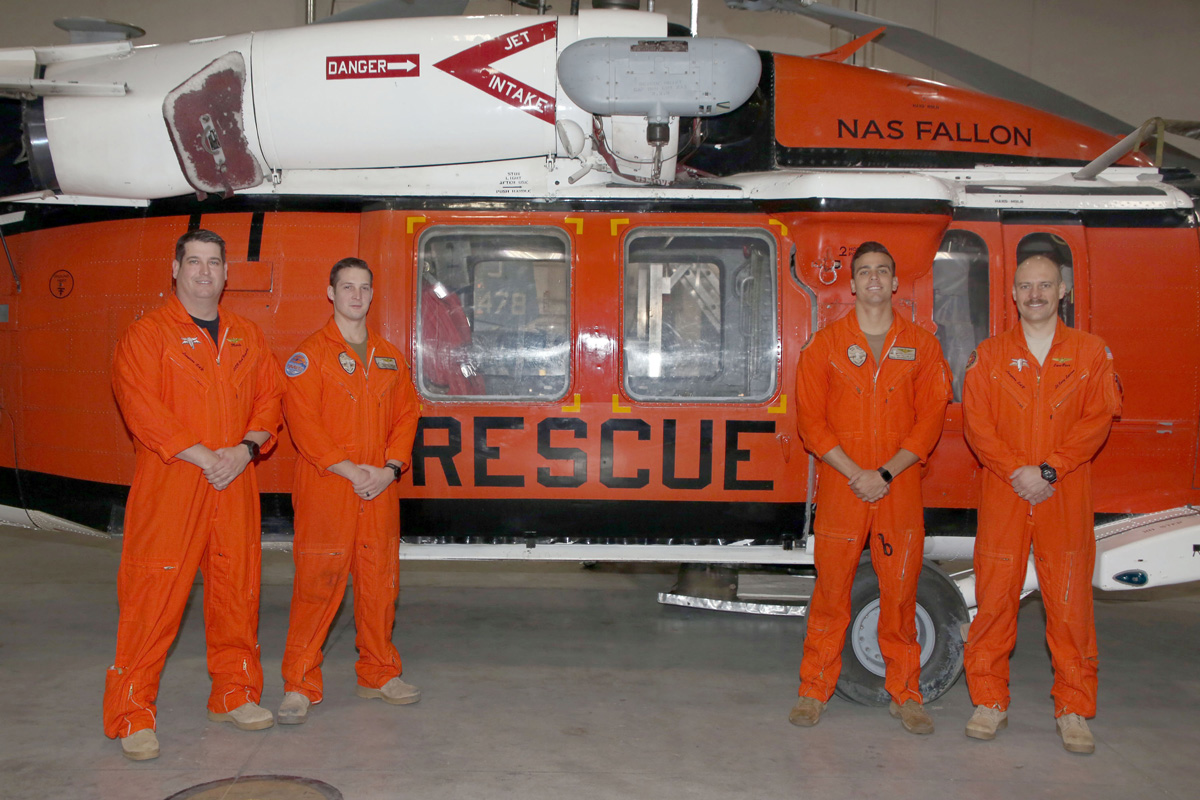Spencerport native aids in rescue of lost snowshoer

by Lt. Cary Lawson
An 80-year-old snowshoer was found and rescued by a Navy helicopter after spending the night in the snowy Sierra Mountains southeast of Lake Tahoe. The Longhorn Helicopter Search and Rescue (SAR) team from Naval Air Station (NAS) Fallon accomplished the rescue at Kingsbury Grade on Monday, January 7.
The crew consisted of mission commander Lt. Cary Lawson, from Loma Linda, California, copilot Lt. Cmdr. Joshua Haggard, from Fairview, Tennessee, crew chief Petty Officer 2nd Class Jacob Glende, from Spencerport, New York, and Helicopter Inland Rescue Aircrewman (HIRA), Petty Officer 2nd Class Michael Dragan-Gosselin, from Hartville, Ohio.
On the evening of January 6, the Douglas County Sheriff’s Office (DCSO) received a 911 call from an 80-year-old snowshoer who was lost and running out of daylight. The snowshoer had 1 percent battery left on his cell phone, but law enforcement was able to obtain a search box before the call was lost.
Ground search and rescue efforts were hampered by nightfall and deteriorating weather.
The SAR team received the request for immediate life-saving response with military aircraft from the DCSO via the Air Force Rescue Coordination Center (ARFCC).
The plan was to launch at sunrise, but weather in the mountains continued to be a limiting factor.
The crew of four departed NAS Fallon at 8 a.m. for the 70-mile transit to Kingsbury Grade near Lake Tahoe. After arriving on scene, the crew searched for an hour before spotting the survivor standing and waving his arms at the bottom of a canyon.
“What struck me most was how difficult it was to spot the survivor in that terrain and the fact that he spent the whole night in the snow storm,” Glende said.
No landing site was available due to steep, mountainous terrain and vegetation, so the crew had Dragan-Gosselin rappel down to the survivor.
“I rappelled 10 feet away from him and immediately sank into waist-deep snow,” Dragan-Gosselin said. “He had been walking in that almost all night without sleeping.”
Once on the ground, Dragan-Gosselin performed a medical assessment of the survivor and prepared him to be hoisted before they were taken up into the aircraft together.
With both men safely onboard, the crew provided in-flight care during the five-minute transit to South Lake Tahoe Airport. The survivor was turned over to ambulance paramedics at 10 a.m. after almost 24 hours in inclement conditions.
NAS Fallon operates three MH-60S Nighthawk helicopters as search and rescue/medical evacuation (SAR/MEDEVAC) platforms for the Fallon Range Training Complex. The rescue, which required expert skill in helicopter mountain rescue techniques, was the first 2019 rescue for NAS Fallon SAR as well as Glende’s first flight as the mission crew chief.
Pursuant to the National SAR Plan of the United States, the unit may also be used for civil SAR/MEDEVAC needs to the fullest extent practicable on a non-interference basis, with primary military duties according to applicable national directives, plans, guidelines and agreements. Specifically, the unit may launch in response to tasking by the AFRCC for inland missions and/or tasking by the NAS Fallon commanding officer for all other aeronautical and maritime regions when other assets are unavailable.
Provided information


